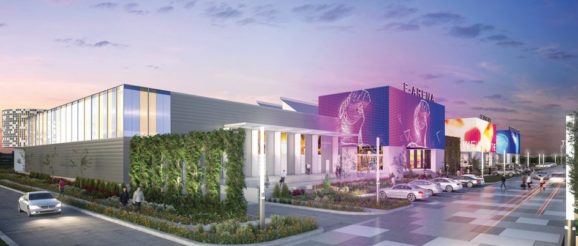Port San Antonio OKs Pact to Develop Innovation Center Esports Facility

Port San Antonio’s board of directors on Wednesday took the first steps toward building a new facility that leaders of the sprawling industrial campus in South San Antonio hope will make it a destination for esports enthusiasts, science education, and innovation.
The board voted unanimously at its monthly meeting to contract American Triple I Partners, a local development firm chaired by former Mayor Henry Cisneros, to lead the design and construction management efforts for an innovation center to be constructed on the 1,900-acre Port San Antonio campus.
The Port’s leadership plans for the center to host esports tournaments, conferences, concerts, and other events. In addition, it will serve as the home of the San Antonio Museum of Science and Technology, or SAMSAT, which houses artifacts and gadgets from the technological past, as well as showcase technology built by Port tenants.
Co-working space and a makerspace, for building devices and working on other projects, will serve both early-stage entrepreneurs and students on the innovation center grounds.
The center will also procure food and beverage vendors.
“We want this facility to represent not just what the Port is today, but what the Port is striving to be and what San Antonio is striving to be – a truly first-class facility,” said Jim Perschbach, the Port’s president and CEO.
The draw of the gaming community is expected to be the main revenue driver at the facility. Perschbach cited market research that predicts esports will trump the income potential of all sports except the NFL. The global esports market is expected to reach $3 billion by 2025, according to recent analysis.
In early 2018, Perschbach took the reins of the Port, a public entity created in the wake of the 2001 closure of Kelly Air Force base, with the charge from board members to pursue a vision that reimagined the Port as a high-technology hub to complement its traditional tenants in the manufacturing, logistics, aviation, and defense sectors.
The shift in focus has wrought more than 2,700 jobs, construction of new office space, and drawn additional tenants, with the growth of the local IT and cybersecurity sectors accounting for much of that activity.
Whereas many of the earliest tenants of the Port located there because they needed runway space for aviation operations or worked closely with the nearby U.S. Department of Defense assets, the Port is now beginning to attract tenants – such as robotics companies Plus One Robotics and Reckon Point – that have more flexibility with regard to the location of their office space.
“We’re now competing for people who don’t have to be here,” Perschbach said. “When you look at the almost 3,000 jobs that we have created in the past year and a half, most of those are projects which we compete with either other parts of San Antonio or, in many cases, with other states.”
Now those employers are looking for quality-of-life amenities to continue to attract talent as well as to give their current employees nearby options for dining, drinking, or entertainment, he said.
“We want it to be a place where people from the campus, people from the neighborhoods can gather,” he said.
The innovation center will also be a source for educating the students of South San Antonio and Southside independent school districts as well as other educational entities in the area. Already operating in a former military chapel, SAMSAT will continue to host camps, field trips, and other educational events with the aim of increasing interest in STEM among schoolchildren. To date, SAMSAT has hosted more than 10,000 area students.
American Triple I was tapped in May to study the feasibility of constructing an innovation center at the Port.
As part of the agreement, American Triple I would agree to operate and manage the innovation center for 20 years. The firm will invest as much as $1 million into the initial phase of the project. The Port and American Triple I will finalize the financing terms by the end of January.
Board member TJ Mayes said American Triple I’s investment mitigates the risk of the project.
“The project always sounded good in theory,” Mayes said. “The question was how do you make the money work? American Triple I bringing in the equity makes me feel more comfortable.”
The firm is expected to return to the board in March with a schematic design, projected costs, and a construction schedule. By July, the Port anticipates breaking ground on the project.
The project has the potential, board members said, to firmly entrench the Port as a high-tech employer. They spoke about the project helping the Port become the 21st-century analog to the job creator that Kelly Air Force base was in the 20th century – except with the potential to create more than just living-wage jobs.
“This is just one more step into not only the future of this part of town but in the future of our city, our state, and our nation,” Chairwoman Chris Alderete said.
